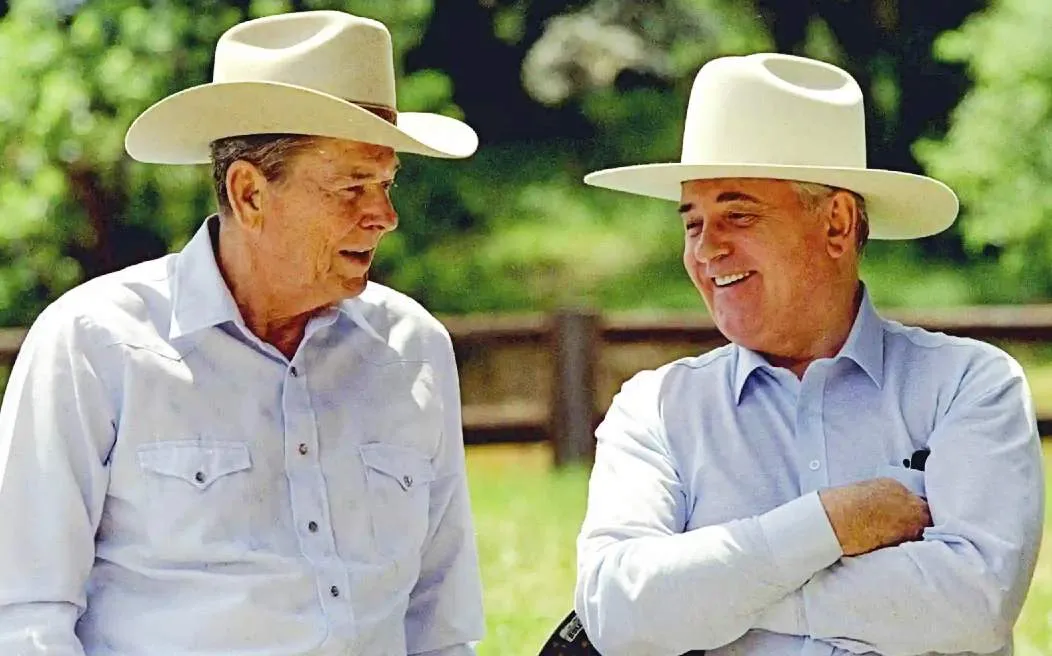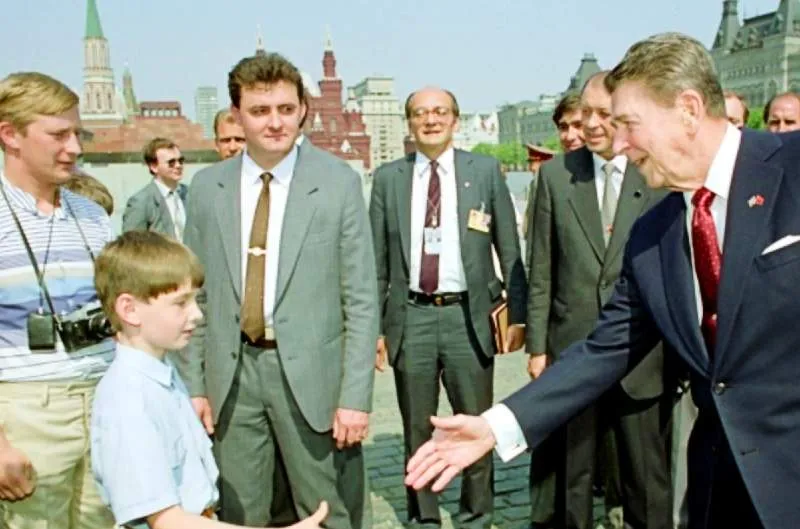Ronald Reagan, Mikhail Gorbachev & The Cold War Spying Game
Ronald Reagan and Mikhail Gorbachev had unusually close ties to the world of espionage long before the US and Soviet leaders brought the Cold War to an astonishing and peaceful end in 1991.
Reagan was determined to roll back communism, which he largely achieved with the revolutions in Eastern Europe in 1989 and the fall of the Berlin Wall. For his part, Gorbachev struck an unprecedented nuclear arms deal with the US and opened up the USSR to the West only to see the union buckle from under him in 1991.
And where were the spies during this incredible period of history? Lurking in the shadows as always.

"The brand new social experience where you activate your gaming skills as you train like a spy."
- TimeOut
Take on thrilling, high-energy espionage challenges across different game zones.

Ronald Reagan, B-movie spy
At the start of WWII, Ronnie Reagan was carving out a career as the affable hero of low-budget, B-movies like Murder in the Air (1939), one of four films featuring Lt. Brass Bancroft, a US Secret Service agent. The films helped stoke anti-Nazi fears even before America entered WWII.
By the time Japan attacked Pearl Harbor in 1941, Reagan was a rising star - so much so, Warner Bros. was anxious about losing Reagan to the US war effort. The studio’s military liaison, an ex-FBI agent named William Guthrie, helped arrange a meeting with the top military brass at San Francisco’s Presidio. As a result, Reagan received a deferment instead of being called up for active service, according to historian Stephen Vaughn, author of Ronald Reagan in Hollywood.
When Reagan did finally report for duty, he was having problems with his eyesight which ensured his deferment was permanent. Instead, Reagan joined the First Motion Picture Unit in California where he narrated and appeared in propaganda films promoting the Air Corps. Now US Army Air Forces Captain Ronald Reagan, he also worked on top-secret training films simulating US flights over bombing targets in Japan.
“Not merely a star, Reagan also became an articulate industry spokesperson and skilled propagandist, playing an important role in the battle to 'capture the minds' of humanity in the struggle against communism,” according to Vaughan’s book.

The FBI in Hollywood
When FBI chief J. Edgar Hoover initiated COM PIC - Communist Infiltration of the Motion-Picture Industry - to ferret out communists, Hoover pressured his L.A. agents to find informants. They identified Reagan as a possible source. The actor had friendly FBI contacts through his college fraternity brothers and was active in groups like the Los Angeles Committee for a Democratic Far Eastern Policy, which the FBI saw as a Communist front pressure group.
According to the Chicago Tribune and other US media, Reagan agreed to tell FBI agents about pro-communist influences in the Screen Actors Guild although Reagan didn’t necessarily support Hoover’s tactics. In at least one FBI interview, Reagan criticized attempts to fire communists from working on Hollywood movies.
Reagan also helped the FBI investigate Baron Paul Emile de Loqueyssie, a French actor suspected of being a Nazi sympathizer. According to FBI files, Reagan said the French actor made anti-Semitic comments at a Hollywood party and that a fight almost erupted. Reagan also noted, however, that “considerable drinking had been done by all persons involved”.
In Reagan’s book, Where’s the Rest of Me? (1965), he recalled the FBI visiting him at home one evening where they “exchanged information for a few hours”. In An American Life (1990), Reagan said the FBI asked to meet periodically to discuss Hollywood: “I said of course they could.”

Ronald & Neil Reagan, spies in the family
Reagan’s brother, Neil, an executive at the McCann Erickson ad agency, was also an informant who described doing ‘little things’ for the FBI, according to Salon: “You know, ‘Neil, we’d like you to go out and lay in the bushes and take down the car numbers off of the cars that are going to be at this little meeting in Bel-Air. Put it in a brown envelope, no return address. And always remember, if you get caught in the bushes, you can just forget about saying, well, you’re doing this for the FBI.’”
Ronald Reagan, meanwhile, was turning his attention from film to politics.
Following a stint as California's governor (1967-1975), Ronald Reagan was elected as the 40th US president in 1981. Initially, he escalated the Cold War with the Soviets, deploying the CIA's Special Activities Division to Afghanistan to train and equip Mujahideen forces against the Soviet Army. Commentators believe Reagan’s goal was to break the Soviet Union so that there was only one world superpower.

The rise and fall of Mikhail Gorbachev
While Reagan was flexing his muscles as America’s elder statesman, a young politician named Mikhail Gorbachev was making headlines around the world.
Gorbachev, general secretary of the Soviet Union Communist Party (CPSU) from 1985 and Soviet Union president 1990–91, was the son of peasants who graduated with a law degree from Moscow State University in 1955 and rose through the Communist Party ranks. Throughout much of this period, Gorbachev maintained crucial connections with the KGB at the highest level in the form of Yuri Andropov, head of Soviet Intelligence for 15 years before Andropov became Communist Party leader in 1982.
According to William Taubmann, author of Gorbachev: Life and Times. Gorbachev had a reputation for loyalty combined with pragmatism and a talent for innovation - qualities Andropov admired. From his hospital bed in 1983, Andropov urged his underlings to choose Gorbachev as his successor as CPSU leader.
Still in his 50s, Gorbachev was seen as a breath of fresh air. His goal was primarily to revive the stagnant Soviet economy but his policies expanded to include glasnost (openness), freedoms of expression and of information, and the repudiation of Stalinist totalitarian rule. In December 1987 he signed an agreement with Reagan to destroy existing stocks of intermediate-range nuclear-tipped missiles and in 1988-89 oversaw the withdrawal of Soviet troops from Afghanistan. Gorbachev was quickly transforming the USSR and by the summer of 1990 had agreed to the reunification of East with West Germany.
Meanwhile, then KGB chief Vladimir Kryuchkov was plotting to force Gorbachev to declare a state of emergency and relinquish power to hard-liners. In August 1991, conspirators briefly placed Gorbachev and his family under house arrest at their vacation home on the Black Sea. Gorbachev survived but his power base was eroding. Boris Yeltsin assumed control and on December 25, 1991, Gorbachev resigned the presidency of the Soviet Union, which ceased to exist that same day.
Vladimir Putin: From KGB spy to president
As the USSR disintegrated, a young, mid-ranking KGB officer named Vladimir Putin was witnessing the fall of the Berlin Wall from his posting in East Germany. Protestors surrounded the Stasi secret police office, but Russian tanks and defense forces were nowhere to be found.
Putin “went from being a member of the most powerful organization, living the good life in East Germany, to somebody who was completely helpless,” Jack Barsky, a SPYEX consultant and former KGB sleeper agent told CBS. “It motivated him to rebuild - not necessarily the Soviet Union, but greater Russia. This is what he is after.”
Putin, also a law graduate, retired from the KGB in 1991 - the year the Soviet Union broke apart - but Putin may not have walked away from the spying game altogether.

Putin’s doppelgänger or the KGB at work?
Reagan’s official photographer Pete Souza snapped the US president in 1998 and insisted that the tourist in the short-sleeved striped shirt was that of young Putin. (Putin's press spokesman denied the photo is of the former KGB spy.)
Whether Putin maintained close ties to the intelligence services or not after leaving the KGB, his steady rise to power continued, leading to his elevation as Russian president and/or prime minister since 2000.
Putin has referred to the USSR’s demise under Gorbachev as the “greatest geopolitical catastrophe of the century”. On August 31, 2022, however, following Gorbachev’s death, the Kremlin paid tribute to the Soviet leader and expressed condolences to Gorbachev’s family saying Gorbachev had a "huge impact on the course of world history".
“He led our country during a period of complex, dramatic changes, large-scale foreign policy, economic, and social challenges,” Putin said. “He deeply understood that reforms were necessary, he strove to offer his own solutions to urgent problems.”
Of the three Cold Warriors, however, only one remains standing.
SPYSCAPE+

Join now to get True Spies episodes early and ad-free every week, plus subscriber-only Debriefs and Q&As to bring you closer to your favorite spies and stories from the show. You’ll also get our exclusive series The Razumov Files and The Great James Bond Car Robbery!


Gadgets & Gifts
Explore a world of secrets together. Navigate through interactive exhibits and missions to discover your spy roles.
Your Spy Skills
We all have valuable spy skills - your mission is to discover yours. See if you have what it takes to be a secret agent, with our authentic spy skills evaluation* developed by a former Head of Training at British Intelligence. It's FREE so share & compare with friends now!
* Find more information about the scientific methods behind the evaluation here.


Stay Connected
Follow us for the latest
TIKTOK
INSTAGRAM
X
FACEBOOK
YOUTUBE